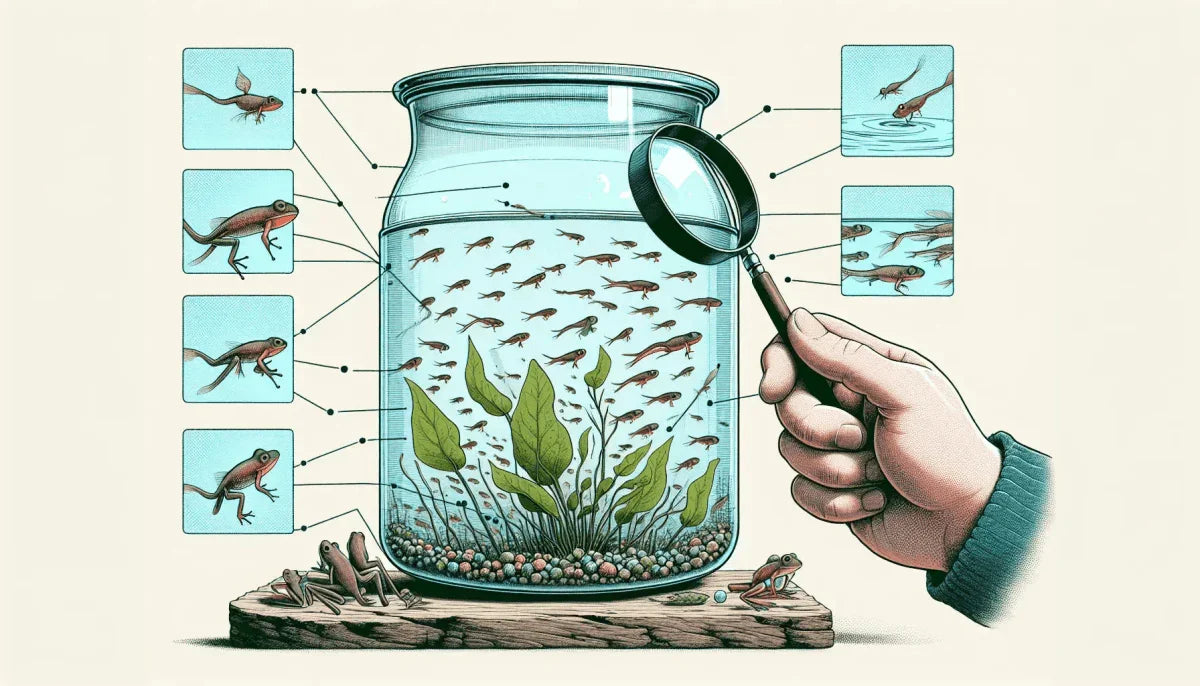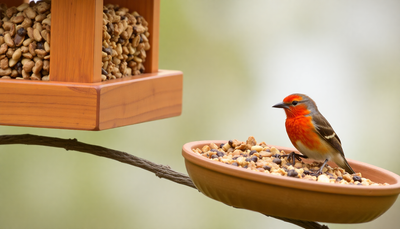Introduction

Importance of understanding the tadpole life cycle
Grasping the tadpole life cycle is essential for successfully raising these fascinating creatures. From their transformation into frogs to their development stages, knowing their needs at each phase can ensure a thriving environment.
Benefits of raising tadpoles as a hobby or educational activity
Raising tadpoles offers numerous benefits, including educational opportunities for children and a relaxing hobby for adults. Observing their growth and metamorphosis can be a rewarding and enlightening experience.
Overview of the step-by-step guide for beginners
This guide aims to simplify the tadpole-raising process for beginners, covering essential aspects such as setting up the tank, caring for tadpoles, managing water quality, feeding, and overseeing their development.
Setting Up the Tadpole Tank
Before you start raising tadpoles, it is essential to set up a suitable tank that meets their specific needs. This section will guide you through the process of choosing the right container, preparing the habitat, and ensuring proper tank conditions.
Choosing the Right Container
The size and material of the container play a crucial role in the well-being of tadpoles. A suitable container should be spacious enough to accommodate the growing tadpoles and made from non-toxic materials. It is recommended to use a plastic or glass aquarium with a capacity of at least 10 gallons to ensure adequate space for the tadpoles to grow and develop.
Preparing the Habitat
Once you have chosen the right container, it is time to prepare the habitat. Start by adding clean, dechlorinated water to the tank, ensuring it is deep enough for the tadpoles to swim freely. Next, add a substrate such as sand or gravel to the bottom of the tank. This will help maintain water quality and provide a more natural environment for the tadpoles.
In addition to the substrate, provide hiding spots and live plants for the tadpoles. These can be rocks, decorations, or aquatic plants. The hiding spots will offer the tadpoles a sense of security, while the plants will help maintain water quality by absorbing excess nutrients.
Setting Up Proper Tank Conditions
Temperature and lighting play significant roles in the development and growth of tadpoles. Maintain a consistent water temperature between 60-70°F (15-21°C), as this range is ideal for most tadpole species. You can use an aquarium heater if needed. As for lighting, a natural day/night cycle is best, so place the tank near a window with indirect sunlight or use a low-intensity artificial light source.
Proper filtration and aeration are essential to ensure a healthy environment for your tadpoles. A gentle sponge filter is recommended, as it helps maintain water quality without creating strong currents that can stress the tadpoles. Additionally, an air pump with an air stone can provide the necessary aeration to keep the water oxygenated.
Talis-us Product Recommendations for Tank Setup
To make setting up your tadpole tank as easy as possible, visit Talis-us for a wide range of products specifically designed for aquatic pets, including aquariums, heaters, filters, and air pumps. Our selection of products ensures that you can find everything you need to create the perfect environment for your tadpoles to thrive.
Gathering and Caring for Tadpoles
One of the first steps in raising tadpoles is to find and collect them. The best time to do this is during the breeding season, which typically occurs in the spring and early summer. Tadpoles can often be found in shallow ponds, marshes, or slow-moving streams. It is important to ensure that you are following safe and ethical collection methods when gathering tadpoles. This may include obtaining permission from landowners or local authorities and avoiding over-collection, which can negatively impact the population.
Once you have collected your tadpoles, it is crucial to acclimate them to their new environment. Begin by gently introducing them to the tank, allowing them to adjust to the water temperature and conditions. This can be done by placing the tadpoles in a container with some of the water they were collected in, and then slowly adding water from the tank to this container over a period of 15-30 minutes. After acclimation, carefully transfer the tadpoles into their new home.
Monitoring the initial behavior and health of your tadpoles is also an essential part of their care. Keep an eye on their activity levels, appetite, and general appearance. Healthy tadpoles should be active and responsive, with no visible signs of injury or illness. By paying close attention to their behavior and health, you can ensure that your tadpoles are well-adjusted to their new environment and are on their way to developing into healthy frogs.
Managing Water Quality
Maintaining water quality is crucial for the health and well-being of tadpoles. Good water quality ensures that tadpoles have a clean and stable environment, which promotes their growth and development. In this section, we will discuss the importance of monitoring and adjusting water parameters, performing regular water changes, and utilizing Talis-us products for water quality management.
Importance of maintaining water quality
Water quality is a critical factor in the survival and development of tadpoles. Poor water quality can lead to stress, disease, and even death. As tadpoles are sensitive to changes in their environment, it is essential to closely monitor water parameters and maintain a clean habitat.
Monitoring and adjusting water parameters
1. pH, ammonia, nitrite, and nitrate levels: Regularly testing the water for pH, ammonia, nitrite, and nitrate levels is essential for maintaining a healthy environment for tadpoles. These parameters should be kept within the recommended ranges, as extreme levels can lead to tadpole stress and illness. If levels are outside the optimal range, adjustments can be made using water conditioners and treatments.
2. Water hardness and temperature: Tadpoles thrive in soft water with a stable temperature. Monitoring water hardness and maintaining a consistent temperature can help prevent stress and promote healthy growth. Use a heater or cooler if needed to maintain the ideal temperature for tadpoles.
Performing regular water changes
1. Frequency and amount of water to change: Regular water changes are necessary to maintain water quality and prevent the buildup of harmful substances. Change approximately 25% of the water every week, ensuring that the new water is treated and has a similar temperature to the existing water.
2. Tips for minimizing stress on tadpoles during changes: To minimize stress on tadpoles during water changes, use a gentle siphon to remove water from the tank, avoiding disturbance to the tadpoles. When adding new water, pour it slowly and gently to prevent sudden changes in water parameters.
Talis-us product recommendations for water quality management
Talis-us offers a wide range of products to help maintain water quality in your tadpole habitat. Consider using water conditioners, testing kits, and filtration systems to ensure optimal water conditions for your tadpoles. Visit the Talis-us website for a selection of high-quality products that can help you effectively manage water quality in your tadpole tank.
Feeding the Tadpoles
Proper nutrition plays a crucial role in the growth and development of tadpoles. Understanding their nutritional needs helps ensure their survival and successful transition into froglets. In this section, we will discuss the types of food suitable for tadpoles, feeding schedules, and some product recommendations from Talis-us.
Understanding the Nutritional Needs of Tadpoles
Tadpoles require a balanced diet to support their rapid growth and development. They mainly consume plant material in their early stages and gradually shift to a more carnivorous diet as they progress towards metamorphosis. It's essential to provide them with the right nutrients and vitamins to support their immune system and overall health.
Types of Food Suitable for Tadpoles
1. Commercial tadpole food: Specially formulated tadpole pellets or powders are available to provide balanced nutrition tailored to their specific needs. These products are designed to support tadpole growth and development and are usually easy to digest.
2. Natural food sources and alternatives: In addition to commercial tadpole food, you can offer natural food sources such as algae, boiled lettuce, or spinach. These provide essential nutrients and help mimic their natural diet in the wild. As tadpoles grow, you can introduce small, live aquatic insects and other protein sources to support their changing dietary needs.
Feeding Schedule and Quantity
1. Adjusting feeding according to tadpole growth and development: Young tadpoles need frequent feedings, typically two to three times per day. As they grow, you can gradually reduce the frequency to once a day. Monitor their growth and adjust the feeding schedule and quantity accordingly to avoid overfeeding or underfeeding.
2. Preventing overfeeding and maintaining water quality: Overfeeding can lead to poor water quality and health issues for tadpoles. Remove any uneaten food after 20-30 minutes to prevent it from decomposing and affecting water parameters. Maintaining a proper feeding schedule and monitoring the tadpoles' behavior can help ensure they receive adequate nutrition without compromising the water quality.
Talis-us Product Recommendations for Tadpole Food
At Talis-us, we offer a wide range of high-quality tadpole food options to support their growth and development. Our selection includes commercial tadpole pellets and powders, as well as natural food sources such as algae wafers and boiled lettuce. Visit our website to explore the best options for your tadpoles' dietary needs and ensure their healthy development.
Overseeing the Development of the Tadpoles
As your tadpoles grow and develop, it's crucial to understand the different stages of their life cycle. This will help you properly monitor and adjust tank conditions, as well as ensure a smooth transition from tadpoles to froglets.
Recognizing the different stages of tadpole development
Tadpoles go through several developmental stages before they become frogs. Initially, they hatch from their eggs and rely on their yolk sac for nutrition. As they grow, they develop external gills, followed by hind legs and eventually, front legs. Their tails gradually shorten as they absorb the nutrients from it, and their internal organs change to adapt to life as a terrestrial animal. Being familiar with these stages will help you better care for your tadpoles throughout their development.
Monitoring and adjusting tank conditions as they grow
As your tadpoles develop, it's essential to make appropriate adjustments to their living environment. Providing more space and hiding spots is crucial for their well-being. You may need to upgrade to a larger tank or add more plants and decorations to accommodate their growing size and increased activity.
It's also important to keep an eye on temperature and water parameters. As tadpoles mature, their temperature and water quality requirements may change. Be prepared to adjust the temperature and conduct regular water tests to ensure your tadpoles continue to thrive in their environment.
Transitioning tadpoles to froglets
As your tadpoles approach the final stages of development, it's important to prepare their tank for metamorphosis. This includes providing structures, such as rocks or branches, that allow them to easily climb out of the water once they develop legs. Additionally, lower the water level to ensure they have easy access to air as they begin to breathe with their lungs.
Adjusting your tadpoles' diet and feeding habits is also an essential part of transitioning them into froglets. As they develop legs and lose their tails, their dietary needs will shift from plant-based foods to insects and other protein-rich sources. Be sure to gradually introduce new food items and monitor their eating habits to ensure a smooth transition.
By closely overseeing your tadpoles' development and making necessary adjustments to their environment and diet, you'll be well on your way to raising healthy, thriving froglets.
Tips and Troubleshooting
In this section, we'll go over common issues and solutions when raising tadpoles, signs of illness and how to address them, and additional resources and support for beginners.
Common Issues and Solutions When Raising Tadpoles
As a beginner, you may encounter a few challenges during the process of raising tadpoles. Here are some common issues and their solutions:
- Cloudy water: Overfeeding or inadequate filtration can lead to cloudy water. To prevent this, feed tadpoles in moderation and ensure the tank has a proper filtration system. Regular water changes can also help maintain water clarity.
- Unhealthy tadpoles: Poor water quality or improper diet can cause tadpoles to become sluggish or show other signs of distress. Monitor water parameters and adjust them as needed, and provide a balanced diet to ensure their well-being.
- Slow growth: Insufficient food or inadequate living conditions can stunt tadpole growth. Ensure you're providing enough food and maintaining optimal tank conditions to promote healthy development.
Signs of Illness and How to Address Them
It's essential to monitor the health of your tadpoles to identify and address any signs of illness early on. Common signs of illness include:
- Lethargy: If your tadpoles are not as active as usual, it could be a sign of illness or stress. Check water parameters and adjust them as needed, and ensure they are receiving a proper diet.
- Abnormal appearance: Discolored, swollen, or damaged body parts can indicate infection or injury. Isolate affected tadpoles to prevent the spread of disease and consult a veterinarian or specialist for advice on treatment.
- Loss of appetite: If your tadpoles are not eating as they should, it could be a sign of illness. Check water parameters and adjust them if necessary, and ensure you're providing a balanced diet. If the problem persists, seek professional advice.
Additional Resources and Support for Beginners
For beginners looking for more guidance and support in raising tadpoles, there are numerous resources available. Consider joining online forums or social media groups focused on amphibian care, where you can connect with other hobbyists and experts. Additionally, consult reputable websites and books on the topic to expand your knowledge and ensure a successful tadpole-raising experience.
Embark on Tadpole Adventures
Throughout this guide, we have explored the importance and benefits of raising tadpoles, providing beginners with a comprehensive step-by-step approach. As a beginner, you now have the knowledge and encouragement needed to confidently begin your tadpole-raising journey. Don't forget to visit Talis-us for all your tadpole-raising needs, offering a wide range of pet products to support your new hobby. Happy tadpole raising!






